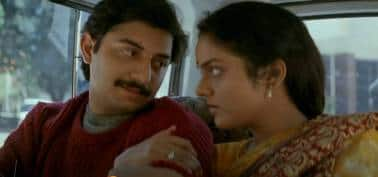



Two films from the year 1992 splintered the film tastes of movie dorks who grew up in India through the '80s on a steady, thrilling as well as exasperating diet of mainstream Bollywood. Films were few, Govinda’s kitschy grotesquerie was edging out new writing that could possibly save us, such movie dorks, from becoming bad versions of Govinda ourselves — at least, at house parties. One was Mansoor Khan’s Aamir Khan-starrer Jo Jeeta Wohi Sikandar, possibly India’s first well-done teenage, campus film, which was to spawn a genre in itself, progressively making the campus film more and more about wealthy brats in love. The other was Mani Ratnam’s Roja, his first film dubbed in Hindi and released in theatres across India as a Hindi film. I was 18.
Even 20 years ago, we knew the south was more serious about its craft, as it was about its stars and their endless hegemonies. We got to watch south films either at film festivals or on Doordarshan’s Sunday afternoon regional language films' slot. In 1981, K Balachander, one of Ratnam’s idols of Tamil cinema, himself directed his Telegu romantic tragedy Maro Charitra (1978) as Ek Duuje Ke Liye. We watched that film in school, amused, curious and thoroughly hooked. I still wonder how the heroine character, which Rati Agnihotri played with utmost relish opposite Kamal Haasan in the hero’s role, survived gulping down what I remember as a tall glass of water mixed with the soot of a letter from her south Indian lover, and which her north Indian father imperiously burnt. That stuff was amorphous carbon. But what a love story — the north-south divide has never seemed that oppressive in a film since Ek Duuje Ke Liye. At that time, we dug parochial humour.
The Hindi film career of the prolific and waywardly talented Malayalam hit-spinner Priyadarshan began in 1993, a year after Roja released in dubbed Hindi, with Gardish, a forgettably tepid action film starring Jackie Shroff and Dimple Kapadia — a remake of the 1989 Malayalam film Kireedam. Through the 2000s, especially after 2010, hundreds of films in south Indian languages started getting dubbed in Hindi or getting remade. The OTT platforms have heralded the culmination of this crossover, making regional language films, mostly south Indian films, a sought-after cornucopia.
 A still from Roja
A still from Roja
So Roja, which Wikipedia and various articles published in Indian dailies in 1992 report, was made on a shoestring budget, was a torchbearer in that sense. But it was much more. In Conversations with Mani Ratnam (2010) by author and film critic Baradwaj Rangan, I understood the Tamil director’s work better. The book has a bit of him as a man and very little of his emotional and personal journey. The book devotes a chapter to Roja, which happens to have AR Rahman’s first-ever film score — a moody spectrum from the lilting bucolic (Dil hai chhota sa) to operatic- romantic (Yeh haseen wadiyaan) to the crescendo-perfect, downright rousing (Bharat humko jaan se pyaara hai). Till then, Ratnam had worked mostly with Ilaiyaraaja, seen by some critics as his musical alter-ego.
It is obvious from Rangan’s self-revealing questions that he and his contemporaries took Ratnam for a director — the first Tamil director — who understood their little rebellions. How could he make a film so heavy on nation-love vis-à-vis Kashmiri militancy? It’s true that Ram Gopal Varma, who, six years later, was going to do some taste-shattering himself with Satya, walked out of the theatre halfway through watching Roja. It offended him that much. For us, it was a breath of fresh air, just like the snow-covered Kashmiri expanse that Santosh Sivan’s camera captured with breathtaking beauty with the couple centre stage — Roja (Madhoo), a village girl from Tirunelveli, Tamil Nadu, and Rishi (Arvind Swamy), a cryptologist from the city, who Ratnam himself has described as a “hip idealist” — arrives there on a honeymoon-cum-work trip. Seriously, Rishi was woke. He didn’t have the interest in diving deep into anything, but he always did the right, politically-correct thing, and spoke his mind, could give a “fuck-you” to his antagonists with a cryptic smile, and a lot more belligerence when push came to shove. For a lot of Tamil film lovers — and it’s probably safe to assume most Tamils are film lovers — Rishi jumping on a burning national flag, hands tied, while being hostage to a Kashmiri terrorist Liaqat Khan (Pankaj Kapur), just to make a point about patriotism, was not only gimmicky, but also a bit blasphemous. For the world outside of this specific purview, here was a director who could marry what he wanted to do and how he envisioned a character, story and milieu with what people might like. Here was a director who could make visuals speak so eloquently that even when the story can outrage you, like Dil Se... (1998) outraged me, one still gave in willy-nilly to the music, and what ensues, without much talking between the characters or between the characters and the setting. He had and has, as Ponniyin Selvan 1 shows, that perfect marriage going.
 Arvind Swamy as Rishi in Roja
Arvind Swamy as Rishi in Roja
The politics was there in Roja, mostly gung-ho nationalistic politics. But the personal was the story, and the backdrop was the layer which catapulted the love story into something that has a dramatic arc — ordinary love, or new, promising love, in the throes of something extraordinary. Till then, we were used to the great masters of the 1970s, what’s known as a canon of parallel cinema, whose message was often more important than the tales, and which produced some powerfully-engaging films. And, on the other hand, we had the Govinda factory and the like, in which cloyingly peppy heroines were always to be wooed and won over until the vermilion shone bright above their foreheads and they became jealous of the misadventures of their husbands. The notable gloriously Bollywood exception the year Roja came out was Benazir and Mehndi — Sridevi in a double role — in Mukul S Anand’s Khuda Gawah. Roja was a woman on two parallel journeys — one was her own emotional expansion and the other was to overcome impossible odds in a land and among people that she knew in her bones are alien and hostile to her.
 Madhoo as Roja in a still from the 1992 film
Madhoo as Roja in a still from the 1992 film
For those who don’t know Roja: She lives in her lush Tirunelveli village, mostly dreaming. Nature is her playground as well as shower room. The name Roja loosely translates to “a red flower”. When a crowd gathers as a prospective groom from the city for Roja’s sister. Ratnam hints right away that this is a bit of an unruly groom through Rishi is quiet swag, his ability to express interest as well as remorse through his eyebrows and one corner of his lips and the sudden decision to light a cigarette the moment before he enters the prospective bride’s home. The sister is brave. She tells Rishi, thinking he will understand her, that she already has a lover and that this marriage for her will be under duress. Rishi’s glance falls on timidly restless Roja and decides he is going to marry her. The marriage happens, much to the frustration and annoyance of the village girl, barely an adult. In the rest of the film, the love between Rishi and Roja grows — and here we see a yin-yang alchemy that’s rooted as much in Indian-ness as it is in the now-decadent idea among the urban intellectual elite that an arranged marriage can be a springboard for romance even when the woman’s heart is not in it to begin with. And Ratnam is a master at projecting this kind of alchemy on screen, which bristles from the premise that a man and a woman are two entirely different entities, emotionally of course, but also in every other way. The stories in most of his films follow a pattern, and at the heart of several is a man-woman relationship. Mouna Ragam (1986), Nayagan (1987), Thiruda Thiruda (1993), Bombay (1995), Iruvar (1997), Dil Se.. (1998), Alaipayuthey (2000), Yuva (2004) — all these films have a man-woman relationship either in flux or thwarted or in conflict, which finally transforms into a magical chemistry. He contemporises mythology with a glossy edge — isn't Rishi-Roja another Satyavan-Savitri? The women in Ratnam’s films have a tenderness and vulnerability which never lets up even as we see her intrinsic steeliness unravel. Roja is such a woman. What Ratnam says in Conversations with Mani Ratnam about Divya, the protagonist that Revathi played in Mouna Raagam — “She gets married, goes to somebody else’s house (which is completely strange), and the strange land accentuates the struggle. The language and the culture are not familiar, and the only person she is familiar with is the person she has a problem with” — is true also of Roja.
 A still from Roja
A still from Roja
It is a film that has truths about India and being Tamil coated in gorgeous visuals. Ratnam is big on Indian-ness/Tamil-ness; his art depends on it. In Roja, there are several pesky relatives around these two characters, unlikely friends in unfamiliar places bonded over mother tongues, and many old ladies. In Rangan’s book, Ratnam says, “We have big families, closely-knit families, and there’s really very little interaction that does not involve different generations. It’s just a reflection of that Indianness.” In Kashmir, lost and yet on a mission to save her new husband, Roja meets Janagaraj, a Tamil man. Her conflict, her desire, her anguish, her fight—her interactions with Janagaraj are ways to let us in on Roja’s state of mind. In Kashmir, the film’s team had to create a character from Tamil Nadu. Not an improbable Indian-ness.
 A still from Roja
A still from Roja
Some of life’s most mundane, but precious moments are spent in a dark theatre — just before the screen lights up and a movie begins. I have never over-lived it. That’s the reason I never miss a Mani Ratnam film. Having watched the first part of Ponniyin Selvan, his latest epochal film series based on Kalki Krishnamurty’s book — and which most Tamil viewers, especially those who have read the books, find problematic, simplistic, etc. — I can’t wait for the second part, which Ratnam has already filmed. Despite being a film with numerous protagonists, a complete break from anything he has done before, the first part is a gorgeous and racy lead-up to the real action ready to unfold in the second. But, here too, like Roja and all his other films, even the sorely misfired ones like Raavan (2010), the spectacle has no aspirations to be Hollywood or Bollywood or any other theatre-worthy format or language of cinema. Its definitive Indian-ness or Tamil-ness, and the ability to modernise mythology and history into potent visual narratives through form is an art that will always be saleable and relevant for artistic scrutiny of any age.
Discover the latest Business News, Sensex, and Nifty updates. Obtain Personal Finance insights, tax queries, and expert opinions on Moneycontrol or download the Moneycontrol App to stay updated!